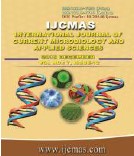


 National Academy of Agricultural Sciences (NAAS)
National Academy of Agricultural Sciences (NAAS)

|
PRINT ISSN : 2319-7692
Online ISSN : 2319-7706 Issues : 12 per year Publisher : Excellent Publishers Email : editorijcmas@gmail.com / submit@ijcmas.com Editor-in-chief: Dr.M.Prakash Index Copernicus ICV 2018: 95.39 NAAS RATING 2020: 5.38 |
Infections caused by multidrug-resistant bacteria expressing ð›½-lactamases pose serious challenges to clinicians worldwide because these bacteria are resistant to a broad range of ð›½-lactams. This study was undertaken to detect extended spectrum β-lactamases (ESBL) and metallo‑beta‑lactamase (MBL) producing Pseudomonas aeruginosa and Acinetobacter species from wound pus and sputum samples. A prospective study was performed over a period of 8 months in a tertiary care hospital. A total of 17 clinical isolates of P. aeruginosa and 18 of Acinetobacter species were tested for the presence of ESBL, and metallo‑beta‑lactamase enzyme. Detection of ESBL was done by the Cephalosporins/Clavulanate Combination Disk method as per Clinical and Laboratory Standards Institute (CLSI) guidelines, and MBL was detected by Imipenem - EDTA Combined disk synergy test. Among 17 isolates of P. aeruginosa, 64.7% were MDR, 41.17 % of were positive for ESBL while 35.2% were MBL producers. Among 18 isolates of Acinetobacter spp, 44.4% were MDR, 16.6% were ESBL producers while 44.4 % were MBL‑producing species. A high prevalence of MDR, ESBL, MBL positive isolates among these non-fermentating bacteria is increasing at an alarming rate. Thus, proper antibiotic policy and measures to restrict the indiscriminative use of cephalosporins and carbapenems should be taken to minimize the emergence of this multiple beta‑lactamase‑producing pathogens.
 |
 |
 |
 |
 |